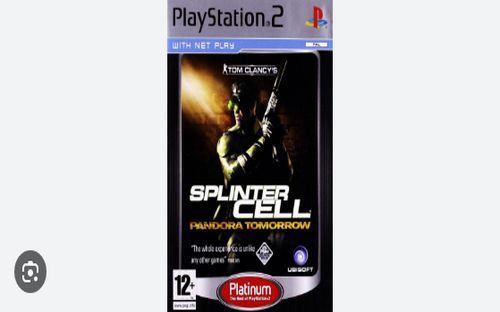The second game in Ubisoft’s acclaimed stealth-action franchise, Tom Clancy’s Splinter Cell: Pandora Tomorrow, expands on the positive aspects of its predecessor while adding new concepts and refinement. Players take on the tactical responsibilities of Sam Fisher, a highly skilled agent of the secret NSA section known as Third Echelon, in this 2004 game. The story revolves around a lethal bioterrorist threat known as “Pandora Tomorrow,” which is codename for a viral weapon that, if left unchecked, might have disastrous results. The game immediately immerses you in a stressful, politically charged environment of international conflict, espionage, and stealth-driven missions spanning several nations.
A fictitious war between the United States and an Indonesian militia under the command of charismatic rebel leader Suhadi Sadono serves as the setting for Pandora Tomorrow. Tensions quickly rise with the audacious abduction of the US ambassador in East Timor, and Sam Fisher must discover Sadono’s scheme, eliminate the threat, and make ethically difficult choices. Tom Clancy’s signature feeling of urgency and multi-layered storytelling, which combines fiction with actual geopolitical issues, are what elevate the plot. The narrative is subtle yet effective in drawing the player into a realistic yet intense setting, and the tempo is still crisp.

Stealth is emphasized throughout the game as the main means of advancement. Pandora Tomorrow encourages patience, observation, and strategic movement, in contrast to many action-packed games. It is advised that players keep in the shadows, pay attention to guard patrols, turn off lights, and, when needed, use non-lethal means. Although the fundamental concepts of the original Splinter Cell are still there, this entry enhances them with improved AI, more fluid animation, and level design that supports a wider range of stealth tactics. Every level seems like a puzzle box just waiting to be solved, complete with ziplines, security lasers, and thermal cameras.
The focus on light and shadow as gameplay elements in Pandora Tomorrow is a significant breakthrough. Gaining proficiency with this system is essential as players have to keep an eye on a light meter that shows their visibility to adversaries. Using devices like flashbangs or adhesive cameras, moving silently, and hiding in the dark create a fun cycle that encourages original thought. Because Fisher lacks superpowers and regenerate health, the game keeps a grounded tone while adding a degree of vulnerability that heightens the tension and tactical nuance.
The level design of the game is one of its best features. From a high-security Israeli airport to a war-torn town in East Timor, missions are conducted in a variety of evocative settings. In addition to having unique visuals, each area offers chances and environmental problems specific to stealth gaming. No two missions seem the same because of this diversity, which keeps the experience interesting. The clever mix of verticality, narrow hallways, and wide areas tests players’ situational awareness and strategy.
The return of Michael Ironside as Sam Fisher’s voice gives the game a steady, grim tone. His cool, astute, and suitably sarcastic voice helps to make Sam more than just a nameless agent. Through believable language and in-mission exchanges, Lambert and other Third Echelon analysts contribute to the immersive experience of the game. Overall, the voice acting is still excellent, preserving the dramatic mood and bringing the high-tech spy narrative down to earth with urgency and human feeling.



One of the most significant multiplayer elements in the history of stealth gaming was also introduced by Pandora Tomorrow. Agile, third-person spies and highly armed, first-person mercenaries square off in the game’s “Spies vs. Mercs” mode. In contrast to conventional deathmatches, the asymmetrical gameplay required participants to employ strategies, collaboration, and divergent viewpoints in order to win. Few games have since been able to match the mode’s cult following and standard for stealth multiplayer design.
System Requirements OF Tom Clancys Splinter Pandora Tomorrow Highly Compressed PC
| Ram | 1 gb |
|---|---|
| Processor | Intel Pentium III |
| Accessories | Keyboard, mouse, and speaker |
| Graphics card | 1 GB |
| Windows | Xp, 7, 8, 8.1, 10, and 11 |
| Free disk space | 1.2 GB |
Pandora Tomorrow stretched the boundaries of the hardware it was published on in terms of design for its time. The feeling of immersion was enhanced by realistic character motions, dynamic lighting, and ambient richness. Environments seemed alive and responsive because of the meticulous attention to visual signals, including shadows, reflections, and even minor things like swinging draperies or flickering displays. By supporting the stealth mechanisms through environment design, these were more than just backgrounds; they were essential components of gaming strategy.
Norman Corbeil, an electronic artist, created the simple yet impactful soundtrack, which emphasizes the suspense of each scene with ambient noises and subliminal clues. The audio design concentrates on ambiance and realism rather than a grand orchestration. In a game where stillness may be your greatest ally—or your downfall—sounds like footsteps echoing in deserted halls, distant conversations, or the flick of a light switch carry a lot of weight. Every sound seems purposeful, and the understated style goes well with the somber tone of the game.
Pandora Tomorrow is still regarded as a pinnacle of stealth gaming twenty years later. Without sacrificing its uniqueness, it expands upon the formula first shown by the original Splinter Cell. The game delivers a distinctive fusion of mood, suspense, and clever gameplay features, pushing players to think like spies rather than merely behave like them. Even if the plot and scope of later installments in the series would change even more, Pandora Tomorrow stands out for striking a balance between difficulty, creativity, and immersion in the realm of clandestine operations.


